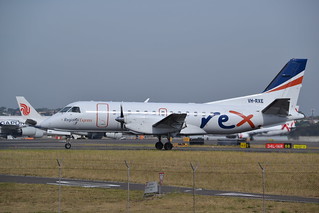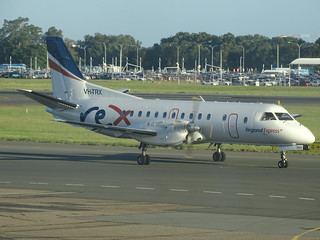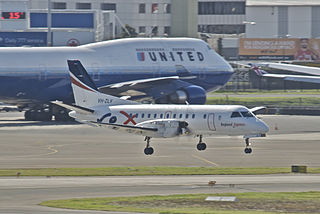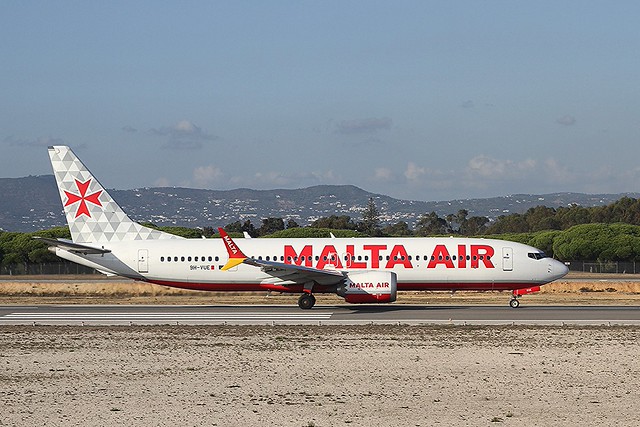REX SF34 at Melbourne on Apr 5th 2022, flames and smoke during engine start prompt evacuation
Last Update: December 4, 2024 / 09:24:35 GMT/Zulu time
Incident Facts
Date of incident
Apr 5, 2022
Classification
Report
Airline
REX Regional Express
Flight number
ZL-3937
Departure
Melbourne, Australia
Destination
King Island, Australia
Aircraft Registration
VH-ZRK
Aircraft Type
SAAB 340
ICAO Type Designator
SF34
On Nov 15th 2022 the ATSB released their preliminary report summarizing the sequence of events:
On 5 April 2022, a Regional Express SAAB 340B aircraft, registered VH-ZRK, was being prepared for an air transport flight from Melbourne, Victoria to King Island, Tasmania. The scheduled departure time was 1445 local time.
The crew consisted of a captain, first officer, and one flight attendant, and there were 23 passengers. Following door closure, the flight attendant commenced the passenger safety briefing using the public address (PA) system.
As was the normal procedure, a marshaller (ground staff member) was positioned at the front of the aircraft to monitor the engine start. The flight crew completed the engine start checklist and started the right engine.
Preliminary review of the closed-circuit television (CCTV), on-board recordings, and interviews with the crew indicated the following sequence of events after the right engine was started:
- A second ground staff member went to the rear right side of the aircraft in preparation to disconnect the ground power unit (GPU).
- The captain began to start the left engine.
- During the left engine start process, the second ground staff member disconnected the GPU from the aircraft (prior to receiving the signal from the flight crew to do so).
- The captain initiated the interrupted engine start procedure for the left engine, which included motoring to remove any residual fuel from inside the engine.
- As the left engine propeller began to rotate, flame and smoke were visible coming from the rear of the left engine. The initial flames were visible on the CCTV for about 3 seconds.
- The marshaller, who was still positioned at the front of the aircraft, noticed the flames and began to signal to the flight crew to stop the engine start using the appropriate hand signal. However, the marshaller could not recall the hand signal for fire3 and instead communicated to the flight crew by mouthing the words ‘smoke’ and ‘flame’ and gesturing to the left engine.
- The captain ceased motoring the left engine and the left propeller stopped.
- At about this time, the flight crew noted that the left engine interstage turbine temperature (ITT)4 was still rising and in response the captain decided to make a second attempt at motoring.
- The marshaller continued to signal to the flight crew that there was a problem, which prompted the captain to check outside their window. The captain could not see any flame or fire. (Note: only the front of the engine is visible from the flight deck).
- There was no indication in the flight deck that there was a fire in the left engine or an overtemperature of the tail pipe; that is, there was no master warning, no relevant indications on the caution and warning panel, no audible chimes and the fire handles were not illuminated.
- The captain later reported that, given the signals from the marshaller and the rising ITT, they decided to action the engine fire emergency checklist and evacuate the aircraft. Accordingly, the flight crew pulled the fire handle for the left engine.
- After the first fire extinguisher bottle had been discharged, additional flame and smoke could be seen coming from the left engine tail pipe.
- The captain cycled the seat-belt sign twice (which created 4 chimes) to notify the flight attendant to evacuate.
- About 30 seconds after the first extinguisher bottle had been discharged, the flight crew discharged the second bottle.
- The captain opened the flight deck door and commanded the flight attendant to commence an evacuation, specifying the use of the forward right (R1) exit only. The captain then attempted to make a PA to the passengers.
- After the right propeller stopped rotating, the R1 exit was opened. Shortly after, the first passenger exited the aircraft. The evacuation of all passengers and crew via the R1 door (Figure 1) took about 4 minutes.
- Two passengers received minor injuries during the evacuation.
- Subsequent examination of the aircraft and engine revealed no damage.
On Dec 4th 2024 the ATSB released their final report concluding the probable causes of the serious incident were:
Contributing factors
- A ground crew member disconnected the ground power unit without having been signalled to do so. This happened while the left engine was starting, which resulted in an interrupted engine start, and the initial development of an engine tailpipe fire.
- After observing the marshaller's signals, the captain stopped motoring the engine. As a result, the fire was not extinguished.
- The captain did not coordinate with the first officer their identification of, or response to, the interrupted engine start or the later fire signals from the marshaller. This limited the opportunity for the first officer to contribute to the identification and management of the ongoing situation.
- Likely associated with increased stress and an escalating sense of urgency, the captain ordered an evacuation without having used all the available information to positively confirm the severity of the situation.
Other factors that increased risk
- The marshaller used non-standard signals when communicating indications of fire to the flight crew.
- Regional Express did not provide flight crew or ground crew recurrent training to review the hand signals required to communicate with each other, including those used in an emergency. (Safety issue)
- Before ordering the evacuation, the captain did not communicate their intent to evacuate the aircraft to the first officer or call for flight deck evacuation drills. In addition, the captain initially did not use the primary method of commanding an evacuation (through the public address system).
- When the captain signalled to the cabin to evacuate (using 4 [seatbelt sign] chimes) the flight attendant did not recognise the signal and subsequently did not react to the command.
- When ordered to evacuate, there were no instructions provided to passengers to direct them to use all the available exits. As a result, the passengers in the emergency exit row did not open a useable exit which delayed the evacuation of the aircraft.
- The captain did not initially communicate the situation to air traffic control, which delayed the arrival of emergency services at the aircraft by about 2 minutes.
- Some passengers took cabin baggage during the evacuation, which increased the risk of injury and delaying the evacuation.
- While flight crew were required to notify ground crew of an aircraft evacuation in some situations, the operator did not provide awareness to ground crew on the actions to be taken in the event of an evacuation.
Incident Facts
Date of incident
Apr 5, 2022
Classification
Report
Airline
REX Regional Express
Flight number
ZL-3937
Departure
Melbourne, Australia
Destination
King Island, Australia
Aircraft Registration
VH-ZRK
Aircraft Type
SAAB 340
ICAO Type Designator
SF34
This article is published under license from Avherald.com. © of text by Avherald.com.
Article source
You can read 1 more free article without a subscription.
Subscribe now and continue reading without any limits!
Read unlimited articles and receive our daily update briefing. Gain better insights into what is happening in commercial aviation safety.
Send tip
Support AeroInside by sending a small tip amount.
Related articles
REX SF34 near Broken Hill on Oct 11th 2025, engine shut down in flight
A REX Regional Express Saab 340B, registration VH-KRX performing flight ZL-6854 from Sydney,NS to Broken Hill,NS (Australia), was enroute at FL120…
REX SF34 at Adelaide on Oct 8th 2025, rejected takeoff due to engine failure
A REX Regional Express Saab 340B, registration VH-ZPN performing flight ZL-4818 from Adelaide,SA to Broken Hill,NS (Australia), was accelerating for…
REX SF34 at Perth on Dec 21st 2022, engine shut down in flight
A REX Regional Express Saab 340B, registration VH-RXE performing flight ZL-2133 from Perth,WA to Albany,WA (Australia), was climbing through about…
REX SF34 at Merimbula on Jun 8th 2023, stick shaker activation on approach
A REX Regional Express Saab 340B, registration VH-TRX performing flight ZL-6139 from Moruya,NS to Merimbula,NS (Australia) with 22 passengers and 3…
REX SF34 at Wellcamp on Oct 21st 2021, wrong position report, loss of separation in traffic circuit
A REX Regional Express Saab 340B, registration VH-ZLV performing flight ZL-5662 from Brisbane,QL to Brisbane West Wellcamp,QL (Australia) with 9…
Newest articles
Malta B38M at Krakow on Dec 8th 2025, sun visor temporarily shuts engine down
An Air Malta Boeing 737-8 MAX on behalf of Ryanair, registration 9H-VUE performing flight FR-3505 from Krakow (Poland) to Milan Bergamo (Italy), was…
Hokkaido AT42 at Okushiri on Dec 16th 2025, problems with left aileron
A Hokkaido Air System Avions de Transport Regional ATR-42-600 on behalf of JAL Japan Airlines, registration JA13HC performing flight JL-2891 from…
Subscribe today
Are you researching aviation incidents? Get access to AeroInside Insights, unlimited read access and receive the daily newsletter.
Pick your plan and subscribePartner

ELITE Simulation Solutions is a leading global provider of Flight Simulation Training Devices, IFR training software as well as flight controls and related services. Find out more.
SafetyScan Pro provides streamlined access to thousands of aviation accident reports. Tailored for your safety management efforts. Book your demo today
AeroInside Blog
Popular aircraft
Airbus A320Boeing 737-800
Boeing 737-800 MAX
Popular airlines
American AirlinesUnited
Delta
Air Canada
Lufthansa
British Airways




